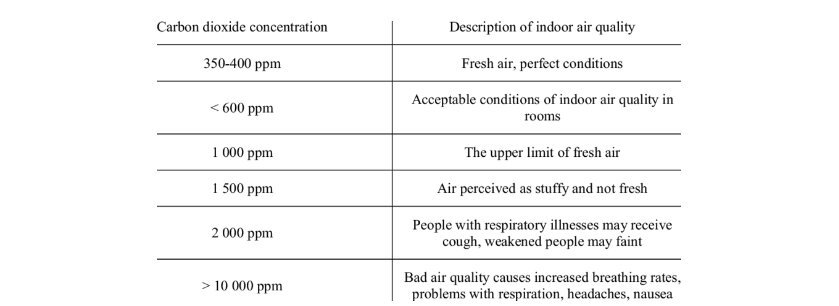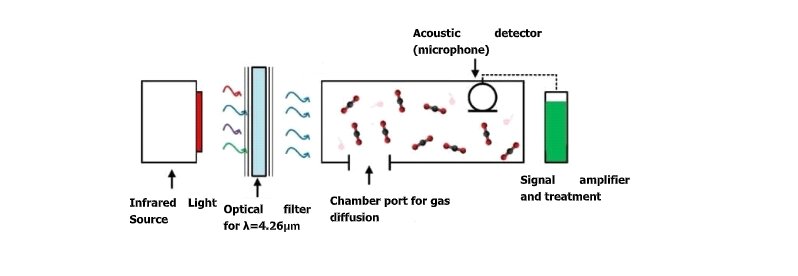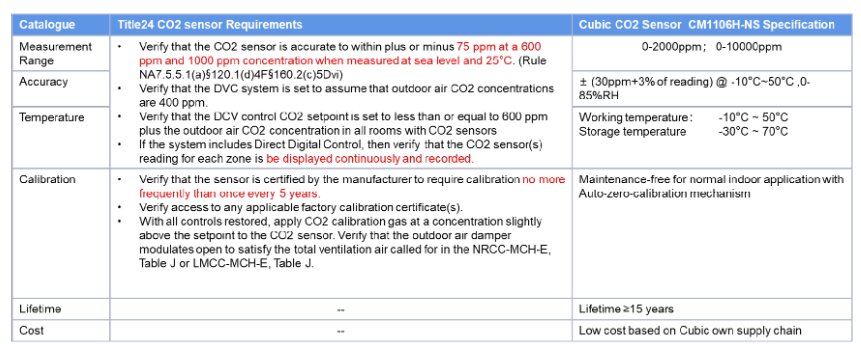
 Favorite (4)
Favorite (4)
When it comes to DCV, the fresh air system will come first. A fresh air system is a system for indoor air treatment and ventilation, with the main function of introducing fresh air, discharging indoor dirty air, filtering and conditioning the air to provide good indoor air quality, and creating a comfortable environment.
DCV is an effective control system used in fresh air systems to improve indoor air quality and achieve energy savings by automatically adjusting the ventilation rate. Typically, one of the most popular and widely available applications is a CO2-based DCV system.
CO2-based DCV system adopts CO2 sensors strategically placed in specific indoor spaces to continuously and accurately monitor indoor CO2 concentration levels in real-time. CO2 sensors will transmit the captured CO2 concentration data to the control unit of the ventilation control system, where the data is processed and analyzed. Usually, before the CO2-based DCV system starts running, the corresponding indoor CO2 concentration threshold is set in advance, and the set thresholds are generally in accordance with ASHRAE standards. When the CO2 concentration exceeds a set threshold, the control unit will send a control signal to the fresh air system to increase ventilation. Once the CO2 concentration drops below
the set CO2 threshold, the fresh air system will reduce indoor ventilation. By applying CO2 sensors, the DCV system can better control ventilation based on actual demand.

CO2-based DCV systems could achieve significant energy savings and improve indoor air quality.
DCV is an effective method for achieving energy savings. Taheri and Razban (2021) conducted an experiment to discuss the difference in total energy consumption between the ventilation system (Current) and the CO2-based DCV system. As is shown in Table 1., a CO2-based DCV system at a CO2 setpoint of 1000 ppm could save 51.4% of energy compared to a ventilation system (Current) with an average fan flow rate of 0.90 m3/s.

The reason why the DCV system achieves more energy savings is simply because the system regulates the ventilation volume by adjusting the fan speed. When there is a need for large ventilation volumes, the fans will operate at high or full speed to meet the demand. Conversely, when only a small amount of ventilation is required, the fans can be operated at low speed or at part load to minimize energy consumption.
Indoor air quality is essential in closed spaces with high occupancy levels. When the indoor CO2 concentration increases, the indoor air quality will be substandard, and occupants will gradually experience physical discomfort if the condition of high CO2 concentration continues. As shown in Table 2, especially when indoor CO2 concentration exceeds 1000ppm, it indicates an indoor environment that deviates from the fresh air conditions, and people will feel uncomfortable. Therefore, a CO2-based DCV system is fundamental, as it could help maintain a comfortable indoor air environment.

Title 24 mandates the application of the DCV system in certain spaces and presents specific requirements for the CO2 sensors incorporated within the DCV system.
“CO2 sensors shall be certified by the manufacturer to be accurate within plus or minus 75 ppm at a 600 and 1000 ppm concentration when measured at sea level and 25℃ factory calibrated, and certified by the manufacturer to require calibration no more frequently than once every five years. Upon sensor failure detection, the system shall provide a signal that resets to supply the minimum quantity of outside air to levels required by Section 120. 1(b)2 to the zone serviced by the sensor at all times that the zone is occupied.”
Based on the rules outlined in Title 24, CO2 sensors should meet the following five key points:
CO2 sensors, integrated into the DCV system, play a crucial role in achieving energy efficiency and maintaining indoor air quality. Based on the requirement from Title 24 about the CO2 sensor in the DCV system, it is essential to select the appropriate CO2 sensor used in the DCV system.
Three widely known technical technologies for measuring CO2 concentration are NDIR (Non-Dispersive Infrared) Technology, PAS (Photoacoustic Spectroscopy) Technology, and Electrochemical Technology.



According to the abovementioned principles, Table 3 has summarized the essential cons and pros of NDIR, PAS, and electrochemical sensors. After conducting a comprehensive comparison of three distinct methods for measuring CO2 based on different technological principles and considering the specific high-precision requirements mandated by Title 24 regulations, it becomes evident that the NDIR CO2 sensor represents the most optimal solution. The NDIR CO2 sensors remarkable performance positions it as the ideal choice for meeting the stringent demands of accuracy in compliance with the regulations.

Based on the advantages of the NDIR technology, the reason the NDIR CO2 sensor is the optimal selection for a DCV system under Title 24 requirements can be further illustrated from below five dimensions below.
NDIR CO2 sensor perfectly meets precision requirements in Title 24, as Title 24 requires CO2 sensors in the DCV system to demonstrate high accuracy within plus or minus 75 ppm at a 600 and 1000 ppm concentration at 25°C. NDIR CO2 sensors can achieve high accuracy of ± (30 ppm+3% of reading) @ -10°C~50°C, 0-85%RH, by precisely designing the light source, filters, and optical path. Current commercial CO2 sensors based on PAS typically achieve accuracy up to ± (50 ppm +5%), which cannot fully satisfy the accuracy requirements of Title 24.
Based on the NDIR principle, NDIR CO2 sensors exhibit high selectivity to accurately measure CO2 concentrations without interference by other gases. At the same time, NDIR CO2 sensors demonstrated the superior performance of being unaffected by vibration. CO2 sensors used for DCV systems are usually placed near ventilation pipelines, where vibration cannot be avoided. It may be challenging for PAS CO2 sensors due to their susceptibility to vibrations, which would affect the accuracy of CO2 concentration measurements.
Title 24 also specifies that CO2 sensors in DCV systems should maintain stability for at least five years. NDIR CO2 sensors adopt an auto-zero-calibration mechanism, which detects and corrects sensor drift or deviations during calibration. The automated calibration approach ensures accurate measurements over the lifetime of CO2 sensors and enables NDIR CO2 sensors to maintain long-term stability without frequent manual calibration within five years.
CO2 sensors’ lifespan should be consistent with the DCV system lifespan for at least 15 years. The optical elements of NDIR sensors are typically made of durable materials with excellent stability for long-term performance. Therefore, NDIR CO2 sensors can easily achieve lifespans exceeding 15 years. In contrast, electrochemical sensors have a short lifespan (often months) and must be replaced frequently, which is not well-suited for fresh air systems.
NDIR CO2 sensors could provide continuous monitoring and real-time feedback on indoor CO2 concentration levels. The capability of timely response is vital for the DCV system, as the adjustment of indoor ventilation strongly relies on changes in CO2 concentration levels.
The demand for CO2 sensors used in DCV systems has increased, especially with the regulatory pressure of adopting DCV systems in multiple indoor spaces under Title 24 requirements. Opting for cost-effective CO2 sensors that meet the requirements becomes crucial. In the past years, NDIR CO2 sensors have been widely applied in IAQ monitoring and HVAC systems, and the annual global market NDIR CO2 sensors volume has surpassed millions. These increasing market demands have led to a continuous cost reduction for NDIR CO2 sensor core components and manufacturing expenses., which creates impetus to enable NDIR CO2 sensor low-cost advantage to be widely adopted in DCV systems. Additionally, due to the auto-zero-calibration mechanism, NDIR CO2 sensors could save time and maintenance costs without manual calibration.
With the advantages of high accuracy, long lifespan, auto-zero-calibration mechanism, and continuous monitoring capability, NDIR CO2 sensors are ideal for DCV systems in compliance with Title 24. Harnessing the real-time CO2 concentration data provided by CO2 sensors, the DCV system dynamically adjusts ventilation rates to meet optimal indoor air quality requirements and achieve energy savings.
Specializing in smart gas sensors and superior gas analyzers, Cubic has established a gas sensing technology platform based on NDIR technology to provide CO2 sensors with the advantages of high accuracy, long lifespan, auto-zero-calibration mechanism, and continuous monitoring capability. In compliance with Title 24 regulations and requirements for fresh air systems, Cubic has specially designed the NDIR CO2 Sensor, CM1106H-NS, which can be used in DCV systems to realize meticulous control to improve indoor air quality and energy efficiency.

CM1106H-NS, developed from NDIR technology, is ideal for the DCV system, which stands at the forefront of technological innovation. It is designed with specific infrared wavelengths and exhibits the critical advantage of high accuracy at ± (30ppm+3% of reading) @ -10°C~50°C, 0-85%RH), ensuring excellent performance in diverse environments.
CM1106H-NS sensor is developed from NDIR technology, leveraging Cubic's extensive 20-year expertise in the field. Adopted with matrix calibration at low (-10℃), normal (25℃), and high (40℃) temperatures and multiple points of CO2 concentration, the CM1106H-NS sensor ensures high accuracy across a wider temperature and measurement range. Additionally, selecting a strict component for the NDIR CO2 sensor guarantees a 15-year lifespan. Based on Cubic’s auto-zero- calibration mechanism, CM1106H-NS can autonomously maintain accuracy across its entire lifetime without frequent manual calibration. Besides, CM1106H-NS also features continuous monitoring of CO2 concentration levels to provide real-time concentration data to the DCV system.

Complemented by a robust and reliable supply chain, Cubic capitalizes on the virtuous synergy of technological innovation, supply chain management, and lean production practices to effectively meet customers' burgeoning demands and provide holistic gas sensing solutions. At the same time, by implementing large-scale production and melding self-developed components for integration, Cubic offers meticulous cost control to provide highly cost-effective products to customers. Cubic also provides tailored service to meet customers’ flexible and diverse product
requirements.
Conclusively, with a 20-year dedication to gas sensing technology, Cubic, a leading manufacturer, will pay continuous attention to policy shifts in Title24 regulations to provide qualified and reliable solutions to customers worldwide. Cubic will also devote its best efforts to the DCV and HVAC application for more influential technological innovations.